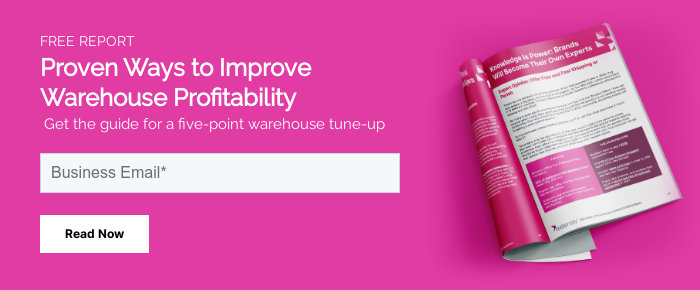Are You Calculating Customer-Level Profitability?
With ecommerce and omnichannel fulfillment driving significant additional volumes into third-party logistics (3PL) warehouses, many 3PLs have seen increased order volume and revenue. However, do those increases naturally translate into improved profitability?
For years, providers in the 3PL industry have operated on razor-thin margins that haven’t expanded at pace or sometimes at all, regardless of the volume flowing through warehouses. Why? While some 3PLs have harnessed increased demand to ensure they bill for additional services and raise prices commensurate with increases in wages, facilities costs, and technology costs, others have retained existing transactional pricing that doesn’t account for customer-level nuances. This variable customer-level profitability can hurt overall warehouse profitability.
Calculating Warehouse Profitability
In the most simplistic terms, profitability equals revenue minus expenses. However, this doesn’t allow a 3PL warehouse manager to capture the nuances required for a 3PL warehouse. To capture enough information to drive customer-level profitability (and to make it actionable), you must break it down into much greater detail:
- Labor Rate and Hours Spent by Customer
- Warehouse Space (cost per sq. foot) vs. Storage Space Used by Customer
- Freight Cost and Markups
- Material Costs and Markups
- Additional Overhead by Customer (e.g., support hours, facilities overhead)
Make sure to calculate labor and warehousing costs as fully burdened, meaning you include direct and indirect costs associated. For example, fully burdened labor costs would include costs for all benefits, bonuses, and/or costs associated with agencies for temps or contract workers. Warehouse space should also include the cost of utilities as well.
Once you understand each of these at the customer level, you can then create your detailed profitability assessment.
Labor Costs
To calculate your labor or handling costs associated with a customer, you’ll first have to identify the hourly wage fully burdened of the team working on the customer’s fulfillment. Then, don’t forget to add in a certain percentage for the supervisors overseeing the team on the account.
Once you have the costs, you’ll need to track hours and activities associated with receipt, put away, picking, packing, shipping, and other management activities related to the customer’s inventory.
Handling Profit Margin = ((Transactional Revenue + Hourly Projects Billed) – Fully Burdened Labor Costs) / Transaction Revenue
If you want to calculate the profitability of labor-related activities tied to order fulfillment alone, then you would pull transactional fees associated with the activities listed above and subtract total labor costs. The best way to capture transaction-related fees is within your warehouse management system (WMS). You can streamline this process by using mobile barcode scanning throughout the inventory lifecycle to ensure you track all potential charges in real-time.
Warehouse Costs
To determine your warehouse operations costs, you’ll need to identify the cost per usable/billable square foot. This means available storage locations and excludes things like your offices and receiving areas. Calculate the total amount of available storage space by square foot, making sure to include vertical storage space as well in your calculation. Once you have usable square feet calculated, you can calculate the cost per square foot as the primary metric you’ll use to start measuring the impact of your cost savings on the bottom line.
Cost Per Square Foot = (Fully Burdened Rent or Mortgage Cost + Utilities + Insurance) / Usable Square Feet
Taking the fully burdened rent or mortgage costs and adding monthly utilities and insurance gives you your total space costs. Calculate Cost per square foot by dividing your space costs by your usable square feet.
Space Profit Margin = (Storage Revenue – (total sq. ft. used x cost per sq.ft.)) / Storage Revenue
Freight
Some 3PL warehouses manage relationships directly with the shipping carriers rather than using customer-provided shipping accounts. This can allow the 3PL to pre-negotiate significantly favorable rates by aggregating volume across all customers. In those instances, freight markups might apply and add another potential area for profit. Many 3PLs have a flat percentage for markup, making freight profitability easy to calculate and measure.
Materials
Materials can get overlooked when it comes to billing and invoicing. Pallets, packaging, labels, and other material-related costs should get captured at the customer level and included in customer invoices unless the customer supplies the packaging. Once again, many 3PLs have a flat percentage markup to ensure a consistent level of profitability on materials.
Overhead
Don’t forget to include customer support, technology, software, and other equipment costs into an overhead calculation. In some situations, like support, you might attribute time to specific customers and bill for support hours. However, for things like technology and equipment, you may have to allocate a percentage to each customer based on their percentage of the business.
Calculating Customer-Level Profitability
To get a good read on customer profitability, calculate the total monthly costs from the sections above and subtract those costs by the total monthly invoice sent to the customer. Then turn it into a percentage so that you can monitor your profit percentages from month to month for fluctuations or changes. Also, by looking at it as a percentage, you can compare how profitable each customer is and adjust your strategies accordingly.
Customer Profit Margin (%) = (Total Invoice/Revenue – (Warehouse Costs + Labor costs + Overhead Costs + Freight Costs + Materials Costs) / Total Revenue
While calculating warehouse customer-specific profitability may sound tedious, it can often help identify which customers need price increases or which customers might not fit within your business model. For example, you might discover that new customers who require labor-intensive kitting as part of their 3PL services may not be a good fit. Additionally, by calculating each section (e.g., 3PL warehouse costs, labor costs, etc.) at the granular level you can get insight into your pricing strategies and where you might need to modify pricing schedules.
Learn More about Customer Profitability
If you want to improve your warehouse’s profitability, consider how you plan and forecast, what competitive advantages you offer, where you can automate warehouse activities, your WMS integrations and connectivity, and how you use your warehouse space. Download the Five Point Warehouse Profitability Tune Up guide from Extensiv to learn how to grow your profits as a logistic provider, or take a look at our 2023 Third-Party Logistics Industry Benchmark Report to learn what other 3PLs are doing to grow their book of business and stay competitive.
You can also contact us to reach out to a warehouse management software expert and learn more. It may be time to invest in new technologies that are cloud-based vs. on-premise in order to optimize your 3PL warehouse workflows and increase customer satisfaction.
About Extensiv
In May 2022, 3PL Central, Skubana, Scout Software, and CartRover combined to become Extensiv. Extensiv is a visionary technology leader focused on creating the future of omnichannel fulfillment. We partner with warehouse professionals and entrepreneurial brands to transform their fulfillment operations in the radically changing world of commerce and consumer expectations. Through our unrivaled network of more than 1,500 connected 3PLs and a suite of integrated, cloud-native warehouse management (WMS), order management (OMS), and inventory management (IMS) software, we enable modern merchants and brands to fulfill demand anywhere with superior flexibility and scale without painful platform migrations as they grow. More than 25,000 logistics professionals and thousands of brands trust Extensiv every day to drive commerce at the pace that modern consumers expect.








